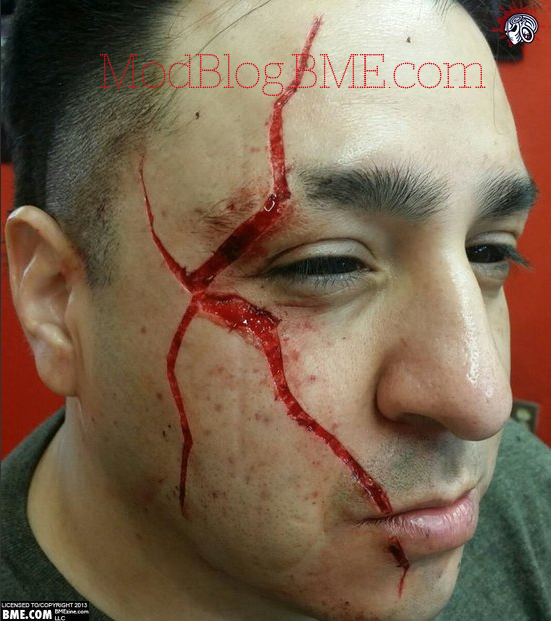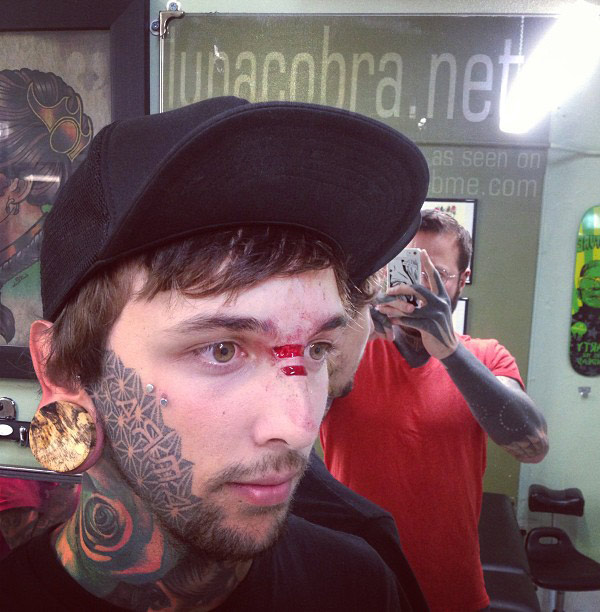This is some serious facial scarification sent in by alfredote.

See more in skin removal scarification.
This is some serious facial scarification sent in by alfredote.

See more in skin removal scarification.
This has to be one of the largest examples of [voluntary] skin removal on a face to date, at least in a single session. It was done by Iestyn Flye –who is normally based at London’s Divine Canvas, but tours extensively so visit him on Facebook for more information no matter where you might be — on Marc at Copenhage Body Extremes (bodyextremes.com). The design is based on a Japanese holy hemp leaf pattern. I can’t wait to see this healed, and will definitely post a follow-up when I can (although if you look at the previous scar that runs across the nose, you can get a good idea of what to expect) — I expect the sort of visage that looks like Freddy Krueger from a distance, and then transforms from horrific to beautiful as you get closer. Click for a larger look.
At the other end of the spectrum of heavily modified people, you’ve got people like Roland Zwicknapp of Visavajara (visavajara.com). He’s let me share this gorgeous portrait shot of him a few years ago by Ethan Oelman. Click the image below to see it uncropped, or save it from this link for a desktop wallpaper sized image.
Cut in half and thus first believed to be a store mannequin when discovered, the body of Elizabeth Short, better known as The Black Dahlia, was found in a truly horrific state. Quoting from Wikipedia,
Short’s severely mutilated body was severed at the waist and completely drained of blood. Her face had been slashed from the corners of her mouth toward her ears, creating an effect called the Glasgow smile. Short also had multiple cuts on her thigh and breasts, where entire portions of flesh had been removed.
I mention this before posting a picture of Kenny Wagner’s new brands, done by Jeremy Pauley of Modern Relic Modifications, so you don’t jump to the conclusion that he’s a Joker (as in Batman‘s nemesis) superfan. Kenny tells me that he’s been long fascinated by the look of an expanded smile with “a darker twist to it” and after coming across images of the Dahlia cuts in horror movies the idea became set in his mind. The horror twist works especially well due to his black eyeball tattoos (the left done by Jeremy who did the brands, and the right by Chance Davis) — although he does admit it gets a little annoying having to constantly hear about Heath Ledger (“…but I’m quite polite most of the time, or sometimes even act like I’ve never even seen the movie!”).

I think most people know of the Maori tradition of facial tattooing or Moko, but I suspect most people see this tradition as being about tattooing (as in using needles to poke a design using ink into the skin). At its roots though it’s more likely an extension of their tradition of wood carving — similar patterns are chiseled into their homes, furniture, and boats. Mokos appear to have began by applying this wood art to the human body, literally chiseling or carving designs into the face, using similar tools for similar results. Some time after this practice began, ink was the added to the scars, making them more visible, and in time the tradition slowly moved away from scarification-based methods to tattooing-based ones. Some early photos show the three dimensional nature of Mokos created using the ink-rubbing scarification technique, although by the time Western anthropologists began documenting the practice it was already falling out of fashion.
Anyway, I was reminded of that history when I saw this skin peel done by John Durante (of Seattle-based jewelry company Evolve), which you can see here both fresh and well into healing. I really like the way he has used a sort of “reverse negative space” by cutting out a simple shape, but leaving a circle of skin in the middle untouched. As to why these facial scars inset rather than raising (as most scars do), it’s possible that it’s some evolution that makes facial injuries less likely to disfigure, it could be due to there being less subcutaneous fat, or it could be due to the vascular nature, but I don’t really have a good explanation as to why the majority of facial scars are “innies” rather than “outies”. If there are any medically aware readers that want to save me some googling, I’m like a Ferengi… all ears.
You don’t have to move far off the face for the scarred skin to start being more likely to raise than stay inset. Here’s another good example of a scar showing fresh versus healing, a throat piece done by Brendan Russell of Tribal Urge in Newcastle, NSW, Australia. The sharp-eyed will notice that this isn’t just a skin removal scar by the way — it’s also an ink rubbing done with white ink, which has the interesting side-effect of making the age of the scar difficult to eyeball.
Speaking of Grace Neutral (I just posted a great set of breast/nipple tattoos she did), I also wanted to update everyone on the amazing skin peel that Howie (lunacobra.net) did on her a while back. It’s healed now, and remains one of my all-time favorite facial scars, not just because of how technically well executed it is, but the unique design. It came about naturally over a few days of Grace and Howie talking about it, followed by drawing it up one night at the shop, tweaking it into perfection. With the ideal design on her face in marker, this is what they created. Her ear points are also Howie’s work by the way.
I had a bridge piercing for all of, oh a month or two almost twenty years ago, and still have very prominent piercing scars at the entrance and exit points, so I can relate to this. If I’m reading his tags right, Dylan, their new tattoo artist at First Blood had some horrible bridge scars, and, well, add Howie (lunacobra.net) to the equation and what’s the easiest way to cover up a scar? A bigger scar! Knowing the way mods progress, should I worry myself with how this has the potential to snowball? It’s like the old lady who swallowed a fly!

Samppa (voncyb.org) has of course done numerous amazing facial scarification projects, many of which have been featured here on ModBlog, but I especially enjoyed this one he just did on Febian (while guesting at Rings of Pleasure). Below it’s pictured both fresh and a week into the healing. The design isn’t purely chaotic — it’s done to mask or reclaim old scars from a car accident (which of course parallels the many scars we’ve seen that cover up old self-injury).
Gosh, I’d forgotten both how fun and how difficult posting here is for me. I’m simultaneously excited and nauseous! But before I call it a night, I wanted to share a few more pieces by Iestyn Flye that he’s posted while I’ve been largely offline. I should also mention, if you didn’t catch it earlier today, that he’s now online at the-absolute.co.uk. Anyway, I will try and post a bit more this weekend but I can’t promise a lot.
This first piece is really interesting and not something you see every day (for all of these I suggest zooming in for a closer look of course). It begins life (the left and middle image) as a skin-removal scar, which is then accentuated once it’s well healed using red dotwork tattooing.
Next, a gorgeous example of facial scarification, with an organic free-flowing piece on one side that has a sort of early Celtic/Viking feel to it, balanced and contrasted on the other side of the face with a series of geometric crosses that instead of being free-flowing, integrate tightly and precisely into the tattoo work done earlier. A stunning and world-class creation.
Finally, the some mind-blowing geometric scarification that would be impressive if done as a tattoo, and unbelievable when done as a scar.